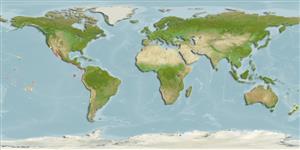Environment: milieu / climate zone / depth range / distribution range
Ekologi
marina bentopelagisk; djupintervall 0 - 50 m (Ref. 9283). Subtropical; 34°N - 18°S, 118°W - 70°W
Eastern Pacific: Redondo Beach in southern California, USA to Peru; rare north of Baja California, Mexico.
Size / Vikt / Age
Maturity: Lm ? range ? - ? cm
Max length : 40.0 cm TL hane/ej könsbestämd; (Ref. 55763); common length : 24.0 cm FL hane/ej könsbestämd; (Ref. 9283)
Short description
Bestämningsnycklar | Morfologi | Morfometri
Body very short, deep, and compressed; lower branch of first gill arch with 30 to 35 gill rakers; dorsal fin with 8 spines followed by another spine and 21 to 24 soft rays (VIII1, 21-24); anterior lobe of second dorsal and anal fins not elongated in adults; anterior dorsal spines prolonged in juveniles; body scaleless; lateral line scutes very weak and poorly differentiated; body silvery to gold with metallic blue highlights; juveniles silvery, with a dark oval stain on the straight part of the lateral line (ref. 55763).
Adults are found in coastal waters up to at least 50 m depth (Ref. 9283). They generally form schools near the bottom (Ref. 9283). Juveniles are encountered near the surface (Ref. 9283). They feed on small fishes and crustaceans (Ref. 9283). Marketed fresh and salted or dried (Ref. 9283).
Life cycle and mating behavior
Könsmognad | Reproduktion | Lek | Ägg | Fecundity | Larver
Eschmeyer, W.N., E.S. Herald and H. Hammann, 1983. A field guide to Pacific coast fishes of North America. Boston (MA, USA): Houghton Mifflin Company. xii+336 p. (Ref. 2850)
IUCN Red List Status (Ref. 130435: Version 2024-1)
Threat to humans
Harmless
Human uses
Fiskeri: mindre kommeriell
Verktyg
Special reports
Download XML
Internet-källor
Estimates based on models
Preferred temperature (Ref.
123201): 20.5 - 28.4, mean 25.1 °C (based on 68 cells).
Phylogenetic diversity index (Ref.
82804): PD
50 = 0.5039 [Uniqueness, from 0.5 = low to 2.0 = high].
Bayesian length-weight: a=0.01622 (0.01061 - 0.02479), b=2.83 (2.71 - 2.95), in cm total length, based on LWR estimates for this species & (Sub)family-body (Ref.
93245).
Trofisk nivå (Ref.
69278): 4.3 ±0.5 se; based on diet studies.
Resiliens (Ref.
120179): Hög, lägsta populationsfördubblingstid mindre än 15 månader (Preliminary K or Fecundity.).
Fishing Vulnerability (Ref.
59153): Low to moderate vulnerability (30 of 100).
Nutrients (Ref.
124155): Calcium = 78.7 [38.4, 176.8] mg/100g; Iron = 1.24 [0.61, 2.65] mg/100g; Protein = 17.8 [15.7, 20.2] %; Omega3 = 0.296 [0.153, 0.593] g/100g; Selenium = 25.7 [11.0, 58.5] μg/100g; VitaminA = 17.2 [4.4, 65.3] μg/100g; Zinc = 0.553 [0.352, 0.864] mg/100g (wet weight);
